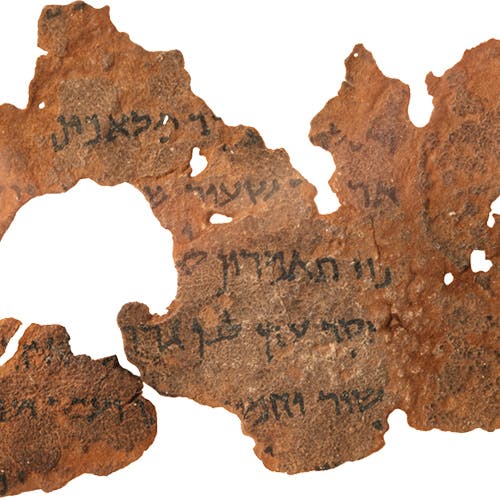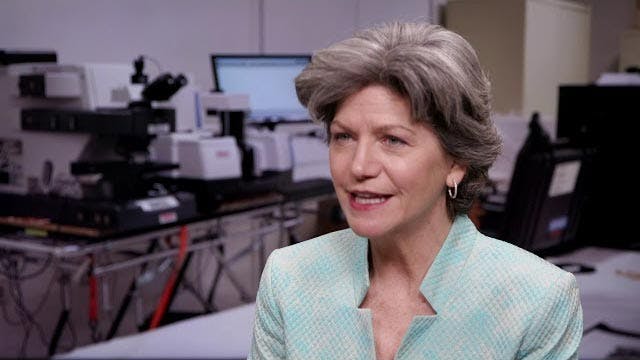Objects with Incomplete Provenance
Dead Sea Scrolls Fragments
1. Following the discovery of the Dead Sea Scrolls (DSS) in the late 1940s and early 1950s, scholars and institutions worked diligently to acquire, organize, and authenticate the newly discovered manuscripts (some complete and many in fragments). Also, during this same time—taking advantage of the excitement generated by the astonishing discoveries—attempts were made to sell forged fragments. Even the earliest scholars involved—like Roland de Vaux—recall seeing forged fragments in the 1950s (Roland de Vaux, “Historique de découvertes,” in Le Grottes de Murabba’at: Texte, eds. Pierre Benoit, Józef T. Milik, and Roland de Vaux, DJD 2:1 [Oxford: Clarendon, 1961], 3–8). This minor and largely forgotten aspect of the DSS story has received renewed attention in recent years, following the appearance, since 2002, of several dozen additional fragments in the antiquities market—fragments that have ended up in the collections of universities, museums, and private collectors.
2. Museum of the Bible curates 16 fragments associated with the Dead Sea Scrolls discoveries. Thirteen fragments were published by a team of scholars in the book Dead Sea Scrolls Fragments in the Museum Collection, Publications of Museum of the Bible 1 (Leiden: Brill, 2016). This book briefly outlines the scrolls’ acquisition history. “The fragments were purchased on behalf of Mr. Steven Green in four lots from four private collectors at the following times and received in Oklahoma City shortly thereafter” (Fragments, 3):
- Four purchased from Dr. Craig Lampe in November 2009: SCR.000120 (Exodus), SCR.000121 (Psalms), SCR.000122 (Leviticus?), SCR.000123 (Instruction).
- One purchased from Michael Sharpe Rare & Antiquarian Books in February 2010: SCR.000124 (Genesis).
- Seven purchased from William Kando in May 2010: SCR.003170 (Daniel), SCR.003171 (Jonah), SCR.003172 (Jeremiah), SCR.003173 (Numbers), SCR.003174 (Ezekiel), SCR.003175 (Nehemiah), SCR.003183 (Micah).
- Four purchased from Andrew Stimer in October 2014: SCR.004742 (Leviticus), SCR.004741, SCR.004768, and SCR.004769 (the latter three are unidentified and were not included in the Brill volume).
3. The four fragments acquired from Dr. Lampe were exhibited in the US between 2004 and 2009, with photos published in the exhibition catalog, The Dead Sea Scrolls to the Bible in America: A Brief History of the Bible from Antiquity to Modern America Told through Ancient Manuscripts and Early European and American Printed Bibles (Biblical Arts of Arizona, 2004). Recently, collections staff obtained images of the fragments taken in the early 2000s by an assistant working with Bruce Ferrini, a key organizer of those exhibitions. One image proves that SCR.004741 and SCR.004768 were previously a single fragment and should now be regarded as a unit (though no text is visible on this fragment). This suggests previous owners either physically altered fragments or neglected to document significant changes.
4. The findspot for these fragments is unknown. “Unfortunately, little is known about the provenance of these fragments because most sellers did not provide such information at the time of the sale . . . they are not connected to either excavations of Bedouin, and several new collections of this type face the same problem” (Fragments, 5).
5. Initially, many assumed these fragments came from the Kando family, one of the first dealers to work with the Bedouin to bring the scrolls to the attention of the world. This would suggest that any fragment purchased from this family could be traced back to the original cave discoveries. Recently, however, scholars have found puzzling features in these “new” fragments, including some of the fragments in the Museum Collections, which calls the authenticity of these newly found fragments into question.
6. A history of the scrolls’ discovery, with special focus on the newly available fragments, is provided in Hanan Eshel, “The Fate of the Scrolls and Fragments: A Survey from 1946 to the Present” and in Torlief Elgvin, Kipp Davis, and Michael Langlois, eds., Gleanings from the Caves. Dead Sea Scrolls and Artifacts from the Schøyen Collection (London: Bloomsbury T & T Clark, 2016). A 2017 issue of the journal Dead Sea Discoveries focuses specifically on the issue of potential forgeries among these fragments, raising further doubts, which are compounded by the lack of credible provenance. (See Kipp Davis, Ira Rabin, Ines Feldman, Myriam Krutzsch, Hasia Rimon, Årstein Justnes, Torleif Elgvin, and Michael Langlois, “Nine Dubious ‘Dead Sea Scrolls’ Fragments from the Twenty-First Century,” pp. 189–228; Eibert Tigchelaar, “A Provisional List of Unprovenanced, Twenty-First Century Dead Sea Scrolls-like Fragments,” pp. 173–88; and Kipp Davis, “Caves of Dispute,” pp. 229–270.) Based on analysis of the parchment, handwriting, ink, letter forms, layout, and correspondences to modern printed texts, Davis argues SCR.003170, SCR.003171, SCR.003172, SCR.003173, SCR.003175, and SCR.003183, in particular, show “puzzling correspondences and alarmingly suspicious features in these fragments [that] should at least disqualify them from discussion as genuine textual artefacts from antiquity and prompt further, urgent investigation into their provenance.”
7. In view of these concerns, the museum sponsored two research projects on the authenticity of the scrolls. Dr. Kipp Davis received a research grant to continue studies of the provenance and paleographical aspects of all the post-2002 fragments, including those in the Museum Collections. In addition, in April 2017 the museum requested scientific testing of five fragments by the Bundesanstalt für Materialforschung und -prüfung (BAM). This testing included 3D digital microscopy and scanning X-ray fluorescence (XRF) material analysis of the ink, sediment layers, and chemical characteristics of the sediment. Their report, received in October 2018, raised further suspicions about the authenticity of all five tested fragments (SCR.000124, SCR.003171, SCR 003173 SCR.003175, and SCR.004742), which display characteristics inconsistent with ancient origin. Museum of the Bible, in consultation with external scholars, removed these from display at the museum pending further research and information.
8. In February 2019, the Museum contracted Art Fraud Insights, LLC to recruit and manage an independent advisory team for the purpose of designing and conducting a rigorous scientific protocol for the imaging and materials analysis of the fragment collection. The goal of the research effort was to gather enough information that would allow for an evidence-based conclusion that would either confirm or refute the authenticity of each fragment. To that end, comprehensive imaging and scientific analysis were conducted on the collection between May and October 2019.
8.1 After an exhaustive review of all the imaging and scientific analysis results, it is the unanimous conclusion of the advisory team that none of the textual fragments in the Museum of the Bible’s Dead Sea Scroll collection are authentic. Moreover, each exhibits characteristics that suggest they are deliberate forgeries created in the twentieth century with the intent to mimic authentic Dead Sea Scroll fragments. Once this determination was made, the advisory team became focused on how they were constructed to deceive. To learn more about the advisory team’s protocols and conclusions, read the full report below.
9. It is important to underscore the complementary roles of the investigation of the provenance, paleography, and material characteristics of the fragments. Scientific testing of manuscripts furnishes helpful information about material features, but that information (like that produced by paleographic research) requires interpretation. The interpretation and overwhelming conclusion of everyone involved is that all 16 fragments in the Museum of the Bible collections are modern forgeries. But even if the scientific tests were inconclusive, the concerns with paleographic oddities (raised by the research of Dr. Kipp Davis and others) and provenance would remain. For this reason, the findings of science, paleography, and provenance research played equally significant roles in reaching these conclusions.
10. As noted in the advisory team’s report, “It is our opinion that all of these methods [in the manuscripts] were utilized with an express intent to deceive. The extensive research sponsored by the Museum of the Bible has resulted in the creation of a rigorous and reproducible protocol for the scientific interrogation of questioned ancient textual artifacts. The field will benefit from the release of the complete research results, which will facilitate comparisons with other questioned fragments. Further, the release of all associated images and datasets will considerably aid the identification and removal of texts that may have contaminated important literary, paleographic, and linguistic datasets.”
Colette Loll of Art Fraud Insights and her team of researchers conducted a battery of scientific tests to determine the authenticity of the museum’s 16 DSS fragments.
The Results
In 2016, 13 of the museum’s fragments were published by a team of scholars in Dead Sea Scrolls Fragments in the Museum Collection. Since publication, scholars have expressed growing concern about the authenticity of some of these fragments — especially since all were purchased after 2002 when suspected forgeries entered the market. Extensive appraisals of the scribal features revealed inconsistencies with authentic DSS. Pending further analysis, Museum of the Bible displayed, upon opening in November 2017, five of its DSS fragments with exhibit labels indicating that authenticity had not yet been verified.
“Notwithstanding the less than favorable results, we have done what no other institution with post-2002 DSS fragments has done,” Museum of the Bible Chief Curatorial Officer Dr. Jeffrey Kloha said. “The sophisticated and costly methods employed to discover the truth about our collection could be used to shed light on other suspicious fragments and perhaps even be effective in uncovering who is responsible for these forgeries.”
Academic Symposium
On March 13, 2020, Museum of the Bible held an academic symposium to share and discuss these findings with the scholarly community. To view the entire presentation click below.

Scientific Research and Analysis

Download the Museum of the Bible Dead Sea Scrolls Collection Scientific Research and Analysis report.
Join the Discussion!

Review the evidence for yourself and see why scholars determined all 16 fragments are modern forgeries. Each fragment revealed unique clues that can now be examined and discussed through a moderated discussion board. For some modern forgeries, like those seen here, you need a microscope to follow the clues.

